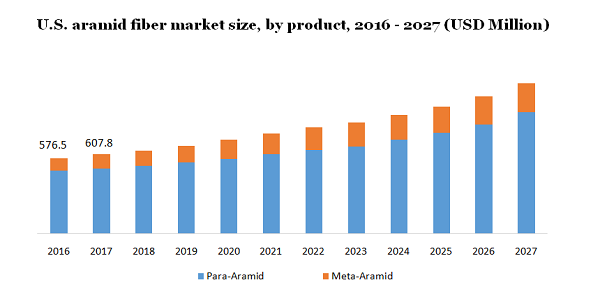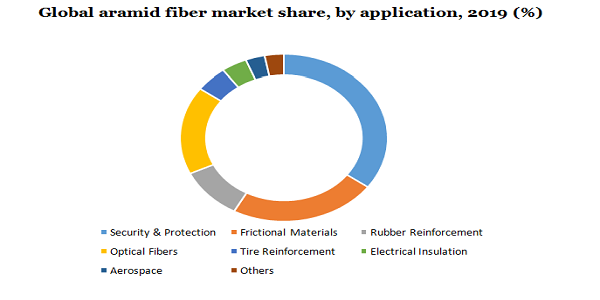- US: +1-408-610-2300
- Toll Free: +1-866-831-4085
- Become a Client
The global aramid fiber market size was accounted for USD 3.6 billion, in 2019. It is projected to ascend with a CAGR of 8.2% from 2020 to 2027. Factors such as growing product demand from several industries such as healthcare, manufacturing, and oil & gas, strict government norms for safety at workplace, increasing preference for flexible and lightweight products for automotive and defense industry, and rising usage in braking systems, gaskets, clutches, and tires are predicted to fuel the market growth over the forecast duration.

The growing application of aramid fibers for combined reinforcement in aircraft, military vehicles, and sports goods is predicted to augment the market growth in the upcoming years. Rising demand for safety equipment such as hand protection, safety goggles, and protective footwear is expected to drive the demand for the product from 2020 to 2027.
The U.S market is predicted to grow with a revenue-centered CAGR of 8.3% and touch USD 1.4 billion by the end of 2027. Growing offshore and onshore drilling activities along with the expansion of the oil & gas industry are projected to bode well for the market growth over the estimated duration.
High cost of production, changing prices of raw materials, and initial investment are expected to restrain the growth of the market in the upcoming years. However, increasing spending on advanced technology aimed at reducing the overall manufacturing cost is predicted to boost the growth of the industry.
Several properties of aramid fibers are heat resistance, toughness, low creep, excellent strength, light-weight, modulus, and high stability are expected to drive the product demand across various industries. Further, extensive preference for aramid fiber in generators and transformers to enhance the performance is also anticipated to supplement the product demand from 2020 to 2027. Other factors such as rising demand for new aircraft, an increasing number of passengers, and preference of aramid fibers in wing assemblies, enclosures, and other internal parts of a helicopter are predicted to drive the product demand over the estimated years.
The para-aramid category led the aramid fibers market in 2019 and is predicted to grow with a revenue-based CAGR of 8.1% over the forecast period. The exceptional durability-to-weight ratio along with excellent tensile strength and modulus behavior is projected to bolster the product demand over the forecast period.
The product has various properties such as excellent flame resistance, elasticity, less prone to chemical resistance, and high ballistic properties. These properties are expected to make it a preferred product across several industries. Moreover, hood resistance to the chemicals is anticipated to boost its demand in many applications across security, frictional, and aerospace materials.
Meta aramid fibers are produced with the help of spinning technology that requires spinning the fiber in chemical and creating a semi-crystalline product. The product is capable of sustaining high temperatures up to 400 centigrade, which makes it a favorable product across several industries.
The meta-aramid category was worth USD 881.4 billion in 2019 and is expected to expand with a revenue CAGR of 8.8% over the estimated period. Increasing application of the product in safety clothing of auto racers, military personnel, protective equipment, and electrical insulation is predicted to bode well for the growth of the market from 2020 to 2027.
The security and protection division held the largest share in revenue in 2019 and is projected to ascend with a revenue-based CAGR of 9.2% over the estimated duration. The growing use of the product in protective clothing and bullet resistance is predicted to augment the product demand in the coming years.
Aramid fiber is widely preferred in aerospace components such as fuselage structure and primary wing in new aircraft, trailing panels, and jetty gear doors. These properties of aramid cable including its impact resistance, light-weight, and excellent strength are anticipated to make it a favorite product in the aerospace sector.

Aramid fibers are widely preferred over asbestos in sealing and friction products. Moreover, the product is also preferred as strengthening in friction products such as clutch plates and brake pads. Further, they are extensively used in seals, high-temperature hoses, and gaskets. Other applications of the product are recreational goods, composites, sealants, and filtration. Abrasion resistance, excellent strength, low density, and impact resistance are few properties that are projected to drive the product demand from 2020 to 2027.
Asia Pacific market touched USD 811.4 million in 2019 and is anticipated to foresee growth due to the increasing employment of security measures across various industries. Moreover, rising penetration of the internet in developing nations, rapid growth, and increasing urbanization in the telecom industry are predicted to supplement the market growth over the estimated period.
Increasing expenditure on the military in developing nations such as India and China owing to rising geopolitical tensions is anticipated to promote the growth of the product in the coming years. Further, growing investments in the healthcare, construction and manufacturing sectors are predicted to propel the demand for the product from 2020 to 2027.
North America is expected to ascend with a revenue CAGR of 8.8% and account for USD 2.1 billion by the end of 2027. The numerous refurbishing activities in the region along with strict norms regarding the protection and security of employees across several industries are anticipated to boost the growth over the forecast years.
The various protection criteria passed by the American National Standards Institute (ANSI) in the U.S. related to workforce protective equipment are expected to accelerate the demand for products such as protective clothing, gloves, and helmets. This is expected to fuel the regional market growth in North America in the upcoming years.
The key players are adopting various initiatives such as technical alliances, M&A, joint ventures, and capacity expansion to maintain their dominance in the market. Further, manufacturers are also emphasizing launching high-quality and cost-effective products to acquire more market share.
For instance, Yantai Tayho Advanced Materials Co. a producer of aramid fiber located in China, spent USD 89 million, in 2018 to widen its para-aramid production centers in China. The initiative taken by the company is predicted to expand its market presence in China and worldwide.
|
Attribute |
Details |
|
The base year for estimation |
2019 |
|
Actual estimates/Historical data |
2016 - 2018 |
|
Forecast period |
2020 - 2027 |
|
Market representation |
Volume in Tons, Revenue in USD Million, and CAGR from 2020 to 2027 |
|
Regional scope |
North America, Europe, Asia Pacific, Central & South America, Middle East & Africa |
|
Country Scope |
U.S., Canada, Mexico, Germany, U.K., France, Italy, Russia, China, India, Japan, South Korea, Brazil |
|
Report coverage |
Revenue forecast, competitive landscape, growth factors, and trends |
|
15% free customization scope (equivalent to 5 analysts working days) |
If you need specific information, which is not currently within the scope of the report, we will provide it to you as a part of the customization |
This report forecasts revenue growth at global, regional, and country levels and provides an analysis of the latest industry trends in each of the sub-segments from 2016 to 2027. For the purpose of this study, Million Insights has segmented the global aramid fiber market report on the basis of product, application, and region:
• Product Outlook (Revenue, USD Million, 2016 - 2027)
• Para-aramid
• Meta-aramid
• Application Outlook (Revenue, USD Million, 2016 - 2027)
• Security & Protection
• Frictional Materials
• Rubber Reinforcement
• Optical Fibers
• Tire Reinforcement
• Electrical Insulation
• Aerospace
• Others
• Regional Outlook (Revenue, USD Million, 2016 - 2027)
• North America
• U.S.
• Canada
• Mexico
• Europe
• Germany
• U.K.
• France
• Italy
• Russia
• the Asia Pacific
• China
• Japan
• India
• South Korea
• Central & South America
• Brazil
• Middle East & Africa


Research Support Specialist, USA